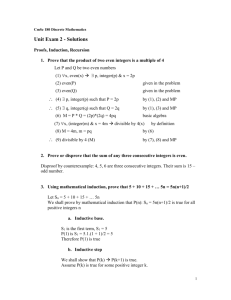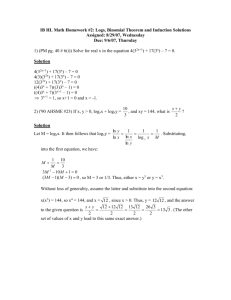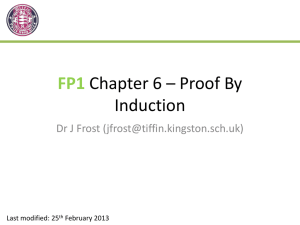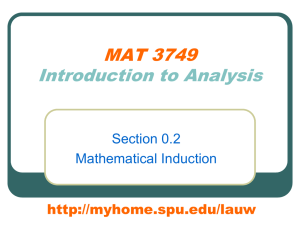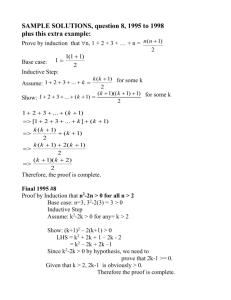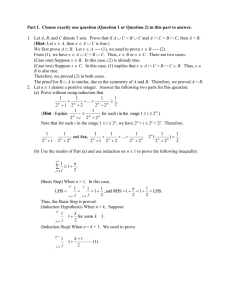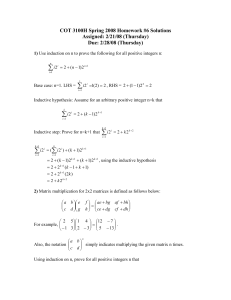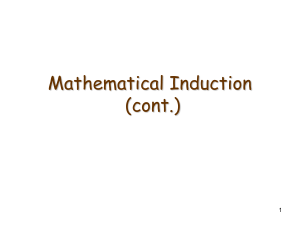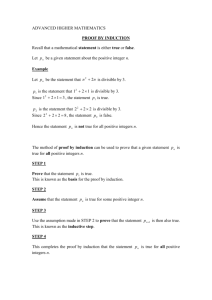Lecture: Induction
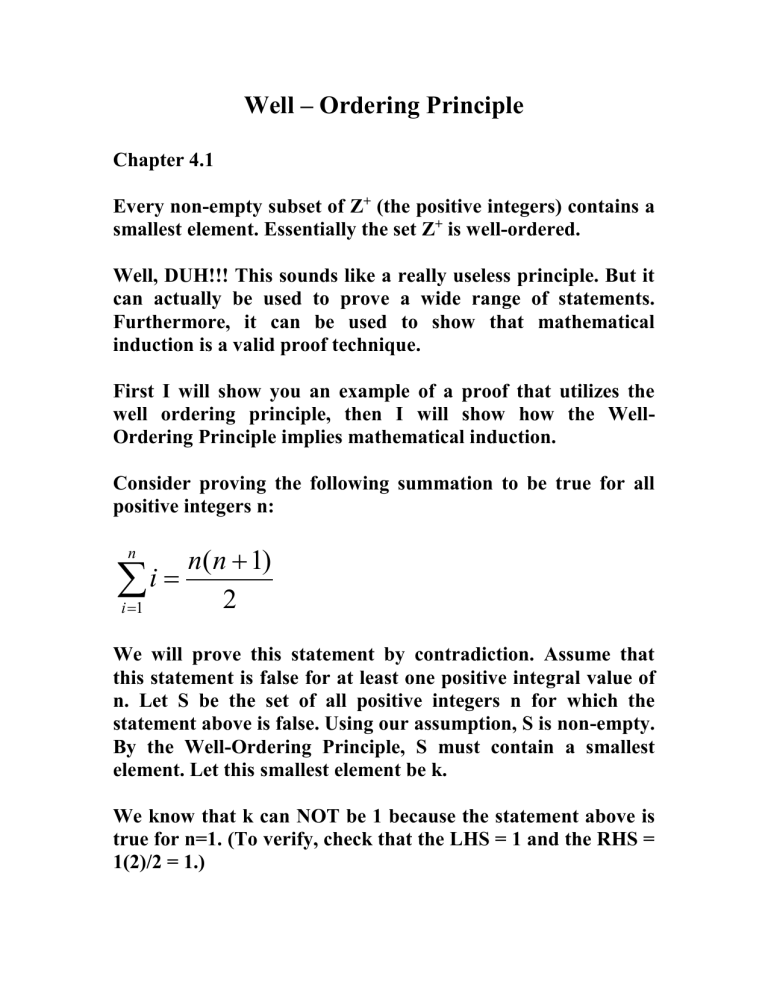
Well – Ordering Principle
Chapter 4.1
Every non-empty subset of Z + (the positive integers) contains a smallest element. Essentially the set Z
+
is well-ordered.
Well, DUH!!! This sounds like a really useless principle. But it can actually be used to prove a wide range of statements.
Furthermore, it can be used to show that mathematical induction is a valid proof technique.
First I will show you an example of a proof that utilizes the well ordering principle, then I will show how the Well-
Ordering Principle implies mathematical induction.
Consider proving the following summation to be true for all positive integers n: i n
1 i
n ( n
2
1 )
We will prove this statement by contradiction. Assume that this statement is false for at least one positive integral value of n. Let S be the set of all positive integers n for which the statement above is false. Using our assumption, S is non-empty.
By the Well-Ordering Principle, S must contain a smallest element. Let this smallest element be k.
We know that k can NOT be 1 because the statement above is true for n=1. (To verify, check that the LHS = 1 and the RHS =
1(2)/2 = 1.)
Thus, k > 1. Furthermore, it follows that k-1>0. Since k-1 is a positive integer less than k, we can deduce that the formula is true for k-1. This means that i
1 k
1 i
( k
1 )(( k
2
1 )
1 )
Now, consider computing the following sum: i k
1 i i k
1 i
k i
1
1 i
k
(
( k k k
( k
2
1 )
1
)
2
1 k k k ( k
2
1 )
2 k
2
) k
2
But, this contradicts our assumption that k was the smallest positive integer for which the formula was false. Thus, our assumption, that such an integer exists is false, and the formula must be true for all positive integral values of n.
Here is the basic idea behind mathematical induction:
The goal of mathematical induction is to prove an open statement s(n) for all non-negative integers n, or all positive integers n. We can do this in the following manner:
1) Show that s(1), the base case, is true.
2) Show that s(k)
s(k+1), for all positive integers k.
We must show that proving the two above statements is equivalent to proving the open statement for all non-negative integers n.
Now, let’s assume that these two conditions could hold while the statement s(n) is NOT true for all positive integers n. This means that we can create a set F = { t
Z
+
| s(t) is false } that is non-empty.
Since this set is a subset of Z + , it must contain a smallest element. Let that smallest element be w. (Thus s(w) is NOT true is our assumption.) We know that w
1 since that is the first requirement for an inductive proof to hold. Thus, we know that w > 1, which means that w-1
Z + .
But, we know that if w-1
Z + , AND that s(w-1) is TRUE because we assumed that w was the SMALLEST value for which s(n) was NOT true. Combining that with the fact that s(k)
s(k+1), for all positive integers k, then we can plug in k
= w-1 to get: s(w-1)
s((w-1)+1) or s(w-1)
s(w), implying that s(w) is true. But, this contradicts our assumption that s(w) is false.
Thus, we can conclude that proving the 2 given statements proves the open statement under consideration.
Mathematical Induction
Often times, we would like to make a statement about the natural numbers (0,1,2,...) such as: for all natural numbers n, the sum of 1+2+3+...+n = n(n+1)/2.
However, proving such a statement may be difficult if we are not very creative or proficient with algebra. In particular, it would be nice if we could prove a given statement without plugging in every possible value of n (which would clearly take forever...) or using terribly clever mathematics.
Induction makes this possible. The induction principle is as follows:
Let A
Z + , where the following two properties hold:
1) 1
A
2) k
A
k+1
A
Then we have that A = Z
+
.
In layman’s terms, the way we will use this principle to prove statements is the following way.
Given an open statement s(n), where n is an arbitrary nonnegative integer, we must show these two following things to prove the statement for all positive integers n:
1) s(1)
2) s(k)
s(k+1) for all positive integers k.
Now, the first step is relatively simple. Since s(1) is a simple statement, you must simply plug in 1 into the open statement and assess the validity of the statement.
The second step must be broken down into two steps. Notice that the second statement is vacuously true if s(k) is false.
Thus, we do NOT care about these cases. Instead, what we must do is the following:
1) Assume that s(k) is true.
Now, under this assumption, we must show that s(k+1) is true.
So that is the following step.
2) Show s(k+1) using the assumption in the previous step.
If you happen to do step 2 WITHOUT any assumption from the previous step, then your proof is not an inductive one, it is merely a direct proof which would have worked if you simply tried to prove s(n) directly to begin with.
Real quickly, here is how it works symbolically...
If we have s(1), and s(k)
s(k+1), we can plug in k=1 so s(1) s(1)
s(2)
s(2)
Then, consider plugging in k=2 so s(2) s(2)
s(3)
s(3)
Continuing in this fashion, we can see that no matter what the value of a positive integer n is, we can eventually show logically that s(n) is true. The reason induction works so well is that it is often much easier to prove the open statement s(k)
s(k+1) than the open statement s(n) directly.
Induction is probably one of the most straightforward proof techniques we will go over in this class. Once you have the algorithm down, you should really be able to finish most inductive proofs. Here are some common mistakes that beginning students make with induction:
1) They do not state what variable they are inducting on. In particular, an open statement may contain more than one variable in it, like the following:
(2a+1) n
1 (mod 2) for all a,n
N.
2) They do not state the assumption being made. This step is easy. All you do is write, “Assume that ...” and replace the ... with the EXACT form of what you are trying to prove.
3) In trying to prove s(k+1) assuming s(k), students will often try to manipulate both sides of an equation, if s(n) is some sort of equation. This is NOT allowed. In order to prove s(k+1), one must take the LHS and manipulate it algebraically until is looks exactly like the RHS. In executing these manipulations, you will have to make a substitution based on the inductive hypothesis from step 2.
Now, consider trying to prove the following for all positive integers n: i n
1 i
2 n ( n
1 )( 2 n
6
1 )
1) Base Case n = 1. Notice in this case that we will show s(1) for our base case instead of s(0). Depending on your problem, your base case can be different values. Typically it will either be s(0) or s(1) though.
This is true since LHS = 1, and RHS = 1(2)(3)/6 = 1.
2) Assume for an arbitrary integer n=k, the statement is true: i k
1 i
2 k ( k
1 )( 2 k
6
1 )
3) Under this assumption we must prove that the statement is true for n=k+1. Thus, we must show:
The sum of the first (k+1) integers squared is i
1 k
1 i
2
( k
1 )( k
1
1 )( 2 ( k
6
1 )
1 )
Note: substitute with (k+1) using parenthesis to avoid a common algebraic error. This is important in statements where the n has a coefficient that will not be distributed correctly without the use of parenthesis.
i
Now, consider computing the following sum: i
1 k
1 i
2
1 k
1 i
2 i k
1 i
2 i k
1
k
1 i
2
Look at notes for Summation Notation for this principle. This step is redundant and unnecessary, but helps illustrate the next step explicitly.
i k
1 i
2
( k
1 )
2
k k k ( k
1 )( 2 k
1 )
6
1
[ k ( 2 k
1
[ 2 k
6
2
6
1 ) k
6
6 k
(
(
k k
6 ]
1 )
1 )]
2
( k
( k
1 )( 2 k
2
1 )( k
6
2 )( 2 k
6
7 k
6 )
3 )
This matches our assumption, so the equality is proven true by mathematical induction.
Two Ways in Which Induction Can Falter
1) Base case can be false.
2) Inductive Step does not work out.
Consider these two examples: i n
1 i
( n
.
5 )
2
2
Plugging into the base case we find, for n=1, LHS = 1, but RHS
= 1.125, so this does not work out. But, consider the inductive hypothesis and step:
Assume for an arbitrary value of n=k that i k
1 i
( k
.
5 )
2
2
Prove for n=k+1 that i
1 k
1 i
( k
1
2
.
5 )
2 i
1 k
1 i
i k
1 i
( k
1 )
( k
2
.
5 )
2
( k
1 )
( k
.
5 )
2
2
2 ( k
1 )
k
2 k
.
25
2
2 k
2
( k k
2
2
3
1 .
k
2
5 )
2
2 .
25
,
which actually works out.
However, the induction is false, because the base case did not work. Obviously the equality is not true if even one possible value of n proves false, therefore this induction was done in error. This example illustrates the importance of the base case step. Don’t forget it!
Now for an example where the base case works, but the inductive step does not: i n
1 i
( n
1 )
2
4
Base case: n=1 LHS = 1, RHS = (1+1)
2 /4 = 1
Assume for an arbitrary value of n = k that i k
1 i
( k
4
1 )
2
Prove for n=k+1 that i
1 k
1 i
( k
1
1 )
2
4 i
1 k
1 i
i k
1 i
( k
1 )
( k
1 )
2
4
( k
1 )
( k
1 )
( k
4
1 )
(( k
( k
4
1 )
5 )
4 )
At this point, hopefully you can see that we will never show that this expression is equal to (k+2)
2 /4. To see this is impossible, plug in k=2 to the value above. This yields 21/4, but when we evaluate to (k+2)
2 /4, we get 4, so obviously the equality is false even though it is true in the base case.
Induction Class Exercise
Using induction prove the following formula for all integers n>0. i n
1 i 2 i
( n
1 ) 2 n
1
2
